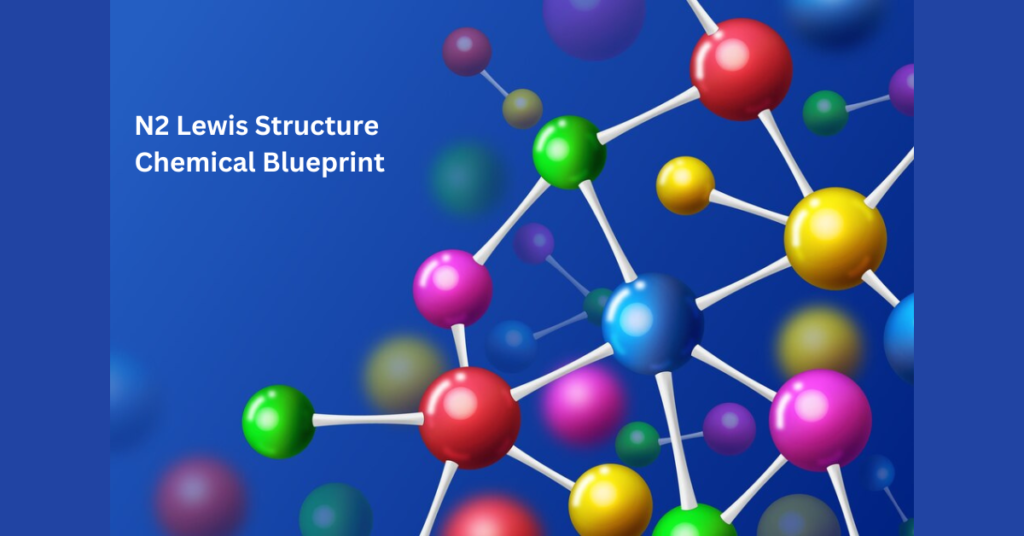Nitrogen, a diatomic molecule (N2), is one of the most abundant elements in the Earth’s atmosphere, comprising about 78% by volume. This simple yet fascinating molecule plays a crucial role in various chemical processes, including those that sustain life. To understand how nitrogen atoms bond together in this diatomic molecule, we turn to the Lewis structure—a diagrammatic representation that illustrates the arrangement of valence electrons among atoms in a molecule. In this article, we will explore the Lewis structure of N2 in detail, diving into the principles that govern its formation, the significance of its triple bond, and its implications in chemistry.
Valence Electrons and the Octet Rule
To begin with, it’s essential to grasp the concept of valence electrons and the octet rule, as they are fundamental to understanding Lewis structures. Valence electrons are the electrons located in the outermost shell of an atom. These electrons are crucial because they participate in chemical bonding. The octet rule states that atoms tend to form bonds in such a way that each atom has eight electrons in its valence shell, achieving a stable electron configuration similar to that of noble gases.
Nitrogen, with an atomic number of 7, has five valence electrons in its outer shell. To fulfill the octet rule, each nitrogen atom needs three more electrons, which can be obtained through bonding with other atoms. In the case of the N2 molecule, two nitrogen atoms bond together to achieve a stable electronic configuration.
Drawing the Lewis Structure of N2
Step 1: Determine the Total Number of Valence Electrons
The first step in drawing the Lewis structure is to calculate the total number of valence electrons available for bonding. Since each nitrogen atom has five valence electrons, a molecule of N2 will have:
5 valence electrons (N1)+5 valence electrons (N2)=10 valence electrons5 \, \text{valence electrons (N1)} + 5 \, \text{valence electrons (N2)} = 10 \, \text{valence electrons}5valence electrons (N1)+5valence electrons (N2)=10valence electrons
These 10 valence electrons need to be distributed between the two nitrogen atoms in a way that satisfies the octet rule.
Step 2: Form the Covalent Bonds
Next, we determine how these valence electrons are used to form covalent bonds between the nitrogen atoms. Nitrogen atoms tend to share electrons to complete their octet, leading to the formation of a triple bond between the two nitrogen atoms.
A single bond (a pair of shared electrons) between two nitrogen atoms would result in the following configuration:
N–N\text{N–N}N–N
However, with just a single bond, each nitrogen atom would only have six electrons in its valence shell (five from itself and one shared from the other nitrogen atom), which does not satisfy the octet rule. Therefore, the nitrogen atoms must form more bonds.
By sharing three pairs of electrons, the nitrogen atoms form a triple bond:
N≡N\text{N≡N}N≡N
This triple bond accounts for six electrons (three pairs) out of the total 10 valence electrons.
Step 3: Place Lone Pairs on the Nitrogen Atoms
After forming the triple bond, four valence electrons remain to be distributed. These remaining electrons are placed as lone pairs on each nitrogen atom:
N≡N\text{N≡N}N≡N ….\text{..} \quad \quad \text{..}….
In this Lewis structure, each nitrogen atom now has a full octet: six electrons from the triple bond and two electrons from its lone pair. This satisfies the octet rule and gives the N2 molecule its stable configuration.
Significance of the Triple Bond
The triple bond in the N2 molecule is a critical feature that defines its chemical properties. A triple bond consists of one sigma (σ) bond and two pi (π) bonds:
- Sigma Bond (σ-bond): This is the first bond formed between two atoms and results from the head-on overlap of atomic orbitals. The σ-bond in N2 is formed by the overlap of the sp hybrid orbitals of the nitrogen atoms.
- Pi Bonds (π-bonds): These bonds are formed by the side-to-side overlap of unhybridized p orbitals. In N2, two π-bonds are formed after the σ-bond, using the remaining p orbitals of the nitrogen atoms.
The triple bond between nitrogen atoms is one of the strongest in chemistry, with a bond dissociation energy of approximately 946 kJ/mol. This strong bond gives the N2 molecule remarkable stability, making it relatively inert under standard conditions. This inertness is why N2 gas does not readily react with other substances at room temperature, contributing to its prevalence in the atmosphere.
Resonance Structures of N2
Resonance is a concept used to describe the delocalization of electrons in certain molecules, where the actual structure is a hybrid of multiple possible Lewis structures. However, for the N2 molecule, there is no significant resonance because the triple bond and lone pairs are fixed in place, and no alternative structures can adequately describe the molecule. The Lewis structure we have drawn—N≡N with lone pairs on each nitrogen—is the most accurate representation of the bonding in N2.
Molecular Geometry and Bond Angles
The Lewis structure of N2 provides insight into the molecular geometry and bond angles of the molecule. Because the N2 molecule consists of only two atoms, its molecular geometry is linear. This linear shape is due to the nature of the triple bond, which aligns the nitrogen atoms in a straight line.
In a linear molecule like N2, the bond angle between the two nitrogen atoms is 180°, meaning the atoms are arranged in a straight line with respect to each other. This linear geometry is consistent with the VSEPR (Valence Shell Electron Pair Repulsion) theory, which predicts that the repulsion between electron pairs around the central atom(s) will arrange them as far apart as possible.
Orbital Hybridization in N2
Orbital hybridization is a concept used to describe the mixing of atomic orbitals to form new hybrid orbitals, which can overlap to form bonds. In the N2 molecule, each nitrogen atom undergoes sp hybridization:
- Sp Hybridization: The nitrogen atom starts with one 2s orbital and three 2p orbitals. In sp hybridization, one 2s orbital and one 2p orbital mix to form two sp hybrid orbitals, which lie in a linear arrangement. The remaining two p orbitals on each nitrogen atom remain unhybridized and participate in the formation of π-bonds.
- Bond Formation: The sp hybrid orbitals of the nitrogen atoms overlap to form the σ-bond, while the unhybridized p orbitals overlap sideways to form the two π-bonds that make up the triple bond.
This hybridization explains the linear geometry and strong bonding in the N2 molecule, as the sp orbitals provide the necessary overlap for the σ-bond, and the p orbitals ensure the formation of the π-bonds.
Bond Length and Strength
The bond length and strength of the N2 molecule are directly related to the nature of the triple bond. The bond length is the distance between the nuclei of the two bonded atoms, while bond strength refers to the amount of energy required to break the bond.
- Bond Length: The triple bond in N2 is shorter than a double or single bond due to the increased overlap of the bonding orbitals. The bond length of the N2 molecule is approximately 109.8 pm (picometers).
- Bond Strength: As mentioned earlier, the bond dissociation energy of N2 is about 946 kJ/mol, making it one of the strongest bonds in chemistry. This high bond energy is due to the three shared electron pairs, which create a strong attraction between the nitrogen atoms.
The combination of a short bond length and high bond strength contributes to the overall stability and inertness of the N2 molecule, making it less reactive under standard conditions.
Applications and Implications of N2’s Lewis Structure
The understanding of the Lewis structure of N2 has practical implications in various fields, including chemistry, biology, and industrial applications.
- Nitrogen Fixation: Despite its stability, nitrogen gas must be converted into a more reactive form to be utilized by living organisms. This process, known as nitrogen fixation, involves breaking the strong N≡N bond to produce ammonia (NH3), a compound that plants can absorb and use to synthesize proteins and other essential molecules. Understanding the strength of the N2 bond is crucial in developing methods to break it efficiently, whether through biological processes (such as the action of nitrogen-fixing bacteria) or industrial processes (such as the Haber-Bosch process).
- Industrial Applications: The stability of N2 makes it an ideal inert gas for use in various industrial applications. For example, N2 is used as a protective atmosphere in the production of semiconductors and in the packaging of perishable foods to prevent oxidation. Understanding the inert nature of N2, as explained by its Lewis structure, helps in designing processes that rely on a non-reactive environment.
- Environmental Impact: The strong triple bond in N2 also plays a role in the nitrogen cycle, a natural process that recycles nitrogen through the atmosphere, living organisms, and the soil. Human activities, such as the use of nitrogen-based fertilizers, can disrupt this cycle and lead to environmental issues like water pollution and the release of greenhouse gases. Understanding the chemical properties of N2, including its Lewis structure, is essential for developing sustainable practices that minimize environmental impact.
Conclusion
The Lewis structure of N2 provides a comprehensive understanding of the bonding, geometry, and chemical properties of this diatomic molecule. By examining how valence electrons are distributed and how atoms bond to satisfy the octet rule, we gain insight into the remarkable stability and inertness of N2. The triple bond between the nitrogen atoms is a key feature that defines the molecule’s behavior, influencing its reactivity, bond strength, and applications in various fields.
Understanding the Lewis structure of N2 is not only fundamental to chemistry but also has broader implications in environmental science, industrial processes, and biological systems. The stability of N2, as explained by its Lewis structure, continues to be a topic of interest for scientists and engineers working to harness the potential of this abundant and essential molecule.
Also Read: Ztec100.com: Bridging Tech, Health, and Insurance for Modern Solutions







